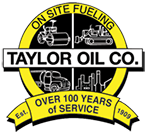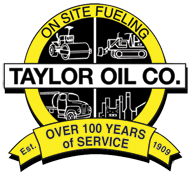Safe Work Practices for Fueling Equipment – Here at Taylor Oil, we’re all about safety. We continually train our technicians on safe work practices for fueling equipment to keep our employees, clients and machinery safe. Due to the highly combustible nature of fuel, it’s imperative that every safety precaution is taken when fueling equipment on site.
Our goal with this blog is to prevent personal injury or property damage as part of the process of fueling equipment.
Potential Safety Hazards
Not surprisingly, there are many potential safety hazards that can arise during this process. Those safety hazards can include but are not limited to:
- Fire
- Explosion
- Spills
- Slips
- Falls
Environmental Concerns
In addition to potential hazards, there are many environmental concerns that arise as well. Spills are the #1 environmental concern in regards to fueling equipment. During storage, transport and the actual act of fueling, oil and other fuel products can be spilled onto the land or in waterways, resulting in a threat to human health and environmental quality, according to the EPA.
That’s why every effort must be made to prevent such spills and, if they do occur, to clean them up immediately and effectively. In addition, the cost of spill prevention is much less than the cost associated with a large-scale cleanup due to the cleanup effort itself, as well as fines and civil liabilities.
Environmental Precautions
To properly guard against spills and other accidents pertaining to fueling equipment, the right precautions must be in place by the fueling provider. These include:
- Spill kit on fuel truck
- Spill kit on mobile equipment
- Designated, trained, skilled fuel administrator
Safe Work Practices
In general, gloves and safety glasses must be worn by anyone administering fuel to equipment. Here are some other helpful suggestions on how to foster a safe work environment and safe work practices.
- Make sure stationary storage fuel tanks have proper ventilation and are well out of the way of buildings. If they are not buried, they should be grounded.
- Transport gasoline in a closed, vented container.
- Check tanks daily for leaks.
- Make sure static chain is attached.
- Keep the metal fill nozzle in contact with the lip of the tank so no static builds up.
- Don’t over-fill tanks.
- Utilize a three-point system when climbing on or off equipment.
- Refrain from smoking during the fueling process.
- Make sure there are no open fires or welding in the fueling zones.
- Equipment should be turned off prior to fueling equipment
- Do not get on equipment until it has been shut off.
- Do not leave fuel pumping unattended.
- Wear proper fall protection
Procedures
Following are the proper procedures for fueling technicians to follow:
- Wait for the Swamper and Operator to signal you to the area before entering.
- Get as close as you can to the equipment.
- Shut off the fuel truck.
- Ask operator to shut off equipment and set attachment to rest.
- Ensure proper grounding of fuel truck and equipment.
- Switch on fuel pump and remove nozzle.
- Ask someone, if available, to hand you the nozzle.
- If not, attach a rope to the nozzle and pull up.
- Remove fuel cap, put in the nozzle and squeeze trigger.
- Release trigger once tank is full.
- Lower the nozzle or hand it to an assistant.
- Get off equipment, then shut off pump.
- Store nozzle.
Responsibilities
Each person at the site has his own unique responsibilities to ensure the fueling procedure goes off without a hitch.
Supervisors/Foremen
- Ensure materials, equipment and manpower are in compliance with safe work practices.
- Address all safety concerns that may arise while performing this procedure.
- Secure all necessary permits.
Employees
- Adhere to all safe work practices and job procedures.
- Wear protective gear.
- Immediately report any accidents or near misses to supervisors.
To discuss further how Taylor Oil keeps you, your company and your equipment safe during fueling, call us today.


